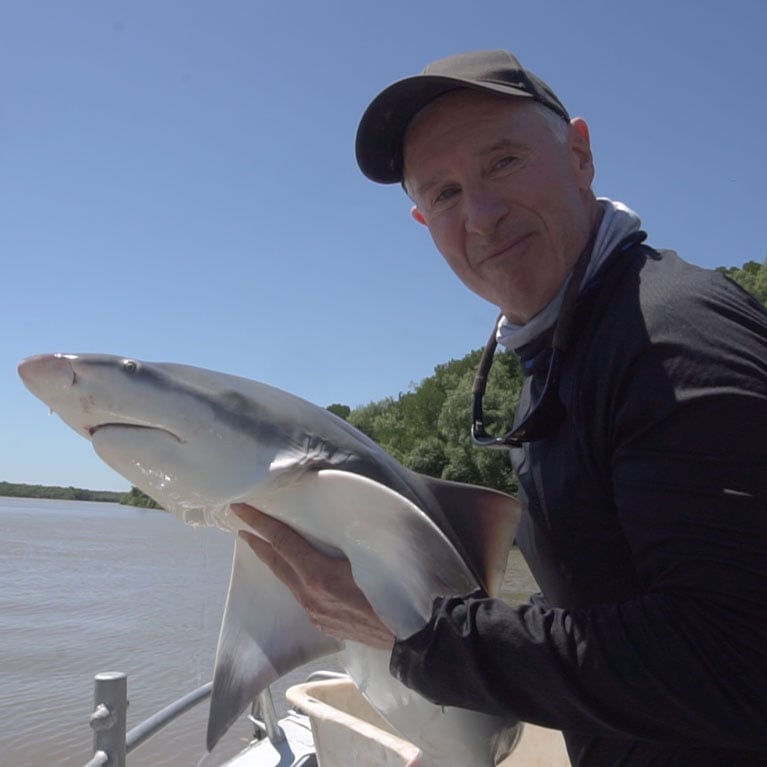Bringing to light the ‘lost sharks’
With more than a third of sharks and rays threatened with extinction, and three sharks possibly already extinct, we’re in a race to document and protect many species before they’re gone. Dave’s interest lies in the details: while many charismatic species might be protected, there are a great many more ‘lost sharks’ that we know almost nothing about and they may disappear before we even recognise them. His project will scour fish markets and landing sites to identify sharks and rays, run training workshops and conduct dedicated searches for ‘lost sharks’ last seen decades ago. Dave plans to document the journey and produce a short documentary to promote awareness about the lost species.
I’m known as the ‘Lost Shark Guy’ and throughout my career I have searched for, and frequently found, those unknown or little-known sharks, rays and ghost sharks that most people know almost nothing about. How did I get interested in sharks? It started with my parents who gave me a book when I was about five years old. Thumbing through the pages and looking at the various illustrations, I thought these were the coolest critters I had ever seen! I was hooked at an early age and decided I was going to make it my lifelong passion to...
Searching for Lost Sharks: Extinct or Alive?
Although a few charismatic species receive much media, conservation and scientific attention, the fate of more than 1,200 species of ‘lost sharks’ remains largely unknown and as many as one-third of all species may be threatened with extinction. This study will bring these ‘lost sharks’ out of the shadows.
A recent global IUCN Red List of Threatened Species reassessment revealed that nearly 40% of chondrichthyans are threatened with extinction. This represents an increase from about 25% of all species in a previous study. Charismatic species are afforded various forms of protection, but the majority of species are disappearing rapidly. Challenges facing chondrichthyans include misidentification, overfishing, habitat loss and degradation, climate change and pollution, as well as lack of fisheries data and political will to implement conservation and fisheries management policies.
A study done in 2014 found that nearly one-quarter of all sharks, rays and ghostsharks (referred to here collectively as ‘sharks’) may be threatened with extinction. A follow-up study in 2021 found that this proportion had increased to about one-third and at least three species may have gone extinct. The current number of observed threatened species is more than twice that of the first global assessment. The scale and drivers of this biodiversity loss were revealed by the International Union for Conservation of Nature’s (IUCN) Red List assessment process. Overfishing and the degradation and loss of habitat are the primary drivers, with pollution and climate change also being contributing factors. Despite the increasing extinction risk, the number of known shark species has increased over the past 15 years and more than 20% of them have been described. At the same time, however, many species have simply vanished. Some species groups have caught the public’s attention through conservation efforts and improved management policies, but many others have remained largely anonymous. Most of the species that are threatened occur in subtropical and tropical coastal waters, in regions considered biodiversity hotspots but where food security is the prime concern of local communities. Yet there is little awareness of the threats these threatened sharks face, as most of them have by and large been ‘lost’, with media coverage focusing on a few charismatic sharks that overshadow the majority. While these charismatic species receive much media, conservation and scientific attention, the fate of more than 1,200 species of ‘lost sharks’ remains practically unknown. This study intends to bring these ‘lost sharks’ out of the shadows.
- With local collaborators, to survey fish markets and landing sites to identify sharks and rays being landed.
- With local collaborators, to conduct identification training workshops.
- To search specifically for ‘lost sharks’ that have not been seen for decades.
- To document the journey.
- To produce a short documentary video (about 15 minutes long) for public outreach and distribution via traditional media outlets (BBC, Discovery, National Geographic) and novel ones (YouTube, podcasts and online streaming services such as EarthxTV). It can also be shown at public speaking events and distributed via the Association of Zoos and Aquariums (AZA) and the Saving Animals From Extinction (SAFE) programme.


